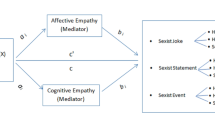Abstract
The purpose of the present study was to investigate the influence of a rape victim's physical attractiveness and resistance to rape on subjects' attributions of responsibility for the crime, certainty of the defendant's guilt, and social perceptions of the rape victim and defendant. Subjects' pretrial empathy toward rape victims and rapists was assessed by scores on the Rape Empathy Scale (RES). In addition to significant sex differences in attributions of responsibility for the incident, subjects' pretrial empathy toward rape victims and rapists was predictive of their perceptions of the rape victim, the defendant, and the rape incident. Victim resistance and attractiveness effects were significant in that subjects responded least favorably to the unattractive rape victim, particularly when she resisted the rape by fighting with her attacker. Male subjects and subjects who exhibited low empathy toward the rape victim were more responsive to subtle manipulations of victim resistance and attractiveness than were females and high RES subjects. Several explanations for these results focus on the cognitive and affective responses of subjects. The implications of the study are discussed in relation to societal attitudes toward rape and the role of sexrole stereotyping, which fosters these attitudes.
Similar content being viewed by others
References
Berscheid, E., & Walster, E. Physical attractiveness. In L. Berkowitz (Ed.), Advances in experimental social psychology (Vol. 7). New York: Academic Press, 1974.
Borgida, E. Evidentiary reform of rape laws: A psycholegal approach. In P. D. Lipsett & B. D. Sales (Eds.), New directions in psycholegal research. New York: Van Nostrand-Reinhold, 1980. Pp. 171–197.
Borgida, E., & White, P. Social perception of rape victims: The impact of legal reform. Law and Human Behavior, 1978, 2, 339–351.
Calhoun, L. G., Selby, J. W., Cann, A., & Keller, G. T. The effects of victim physical attractiveness and sex of respondent on social reactions to victims of rape. British Journal of Social and Clinical Psychology, 1978, 17, 191–192.
Calhoun, L. G., Selby, J. W., & Warring, L. J. Social perception of the victim's causal role in rape: An exploratory examination of four factors. Human Relations, 1976, 29(6), 517–526.
Costrich, N., Feinstein, J., Kidder, L., Maracek, J., & Pascale, L. When stereotypes hurt: Three studies of penalties for sex-role reversals. Journal of Experimental Social Psychology, 1975, 11, 520–530.
Crowne, D., & Marlowe, D. The approval motive. New York: Wiley, 1964.
Davis, J. H., Kerr, N. L., Stasser, G., Meek, D., & Holt, R. Victim consequences, sentence severity, and decision processes in mock juries. Organizational Behavior and Human Performance, 1977, 18, 346–365.
Deitz, S. R. Double jeopardy: The rape victim in court. Rocky Mountain Psychologist, Fall 1980, pp. 1–17.
Deitz, S. R., & Byrnes, L. E. Attribution of responsibility for sexual assault: The influence of observer empathy and defendant occupation and attractiveness. Journal of Psychology, 1981, 108, 17–29.
Deitz, S. R., Blackwell, K. T., Daley, P. C., & Bentley, B. J. Measurement of empathy toward rape victims and rapists. Journal of Personality and Social Psychology, 1982, 43, 372–384.
Dermer, M., & Thiel, D. L. When beauty may fail. Journal of Personality and Social Psychology, 1975, 31(6), 1168–1176.
Dion, K., Berscheid, E., & Walster, E. What is beautiful is good. Journal of Personality and Social Psychology, 1972, 24(3), 285–290.
Ellison, K. W. The “just world” in the “real world”: Attributions about crime as a function of group membership, victim precipitation and injury. Unpublished doctoral dissertation, City University of New York, 1976.
Feild, H. S. Juror background characteristics and attitudes toward rape: Correlates of jurors' decisions in rape trials. Law and Human Behavior, 1978, 2(2), 73–93.
Feldman-Summers, S., & Lindner, K. Perceptions of victims and defendants in criminal assault cases. Criminal Justice and Behavior, 1976, 3(2), 135–150.
Fulero, S. M., & DeLara, C. Rape victims and attributed responsibility: A defensive attribution approach. Victimology, 1976, 1(4), 551–563.
Hilberman, E. Rape: The ultimate violation of the self. American Journal of Psychiatry, 1976, 133(4), 436–437.
Howitt, D. Situational and victims' characteristics in simulated penal judgments. Psychological Reports, 1977, 40, 55–58.
Jones, C., & Aronson, E. Attribution of fault to a rape victim as a function of respectability of the victim. Journal of Personality and Social Psychology, 1973, 26(3), 415–419.
Kahn, A., Gilbert, L. A., Latta, M., Deutsch, C., Hagen, R., Hill, M., McGaughey, T., Ryen, A. H., & Wilson, D. W. Attribution of fault to a rape victim as a function of respectability of the victim: A failure to replicate or extend. Representative Research in Social Psychology, 1977, 8, 98–107.
Kanekar, S., & Kolsawalla, M. B. Responsibility in relation to respectability. Journal of Social Psychology, 1977, 102, 183–188.
Kerr, N. L. Beautiful and blameless: Effects of victim attractiveness and responsibility on mock jurors' verdicts. Personality and Social Psychology Bulletin, 1978, 4(3), 479–482.
Kerr, N. L., & Kurtz, S. T. Effects of a victim's suffering and respectability on mock juror judgments: Further evidence on the just world theory. Representative Research in Social Psychology, 1977, 8, 42–56.
Kirk, R. E. Experimental design: Procedures for the behavioral sciences. Belmont, Calif.: Brooks/Cole, 1968.
Krulewitz, J. E., & Nash, J. E. Effects of rape victim resistance, assault outcome, and sex of observer on attributions about rape. Journal of Personality, 1979, 47(4), 557–574.
Krulewitz, J. E., & Payne, E. J. Attributions about rape: Effects of rapist force, observer sex and sex role attitudes. Journal of Applied Social Psychology, 1978, 8(4), 291–305.
Landy, D., & Aronson, E. The influence of the character of the criminal and his victim on the decisions of simulated jurors. Journal of Experimental Social Psychology, 1969, 5, 141–152.
Luginbuhl, J., & Mullin, C. Rape and responsibility: How and how much is the victim blamed? Sex Roles, 1981, 7(5), 547–559.
Metzger, D. It is always the woman who is raped. American Journal of Psychiatry, 1976, 133(4), 405–408.
Penhallow, C. Sexual assault: Attribution of fault to victims and evaluation of victims. Dissertation Abstracts International, 1978, 39(3), 1547–1548.
Rumsey, M. G., & Rumsey, J. M. A case of rape: Sentencing judgments of males and females. Psychological Reports, 1977, 41, 459–465.
Russell, D. E. H. The politics of rape: The victim's perspective. New York: Stein & Day, 1975.
Schwendinger, J. R., & Schwendinger, H. Rape myths: In legal theoretical, and everyday practice. Crime and Social Justice, 1974, 1, 18–26.
Scroggs, J. R. Penalties for rape as a function of victim provocativeness, damage, and resistance. Journal of Applied Social Psychology, 1976, 6(4), 360–368.
Selby, J. W., Calhoun, L. G., & Brock, T. A. Sex differences in the social perception of rape victims. Personality and Social Psychology Bulletin, 1977, 3, 412–415.
Seligman, C., Brickman, J., & Koulack, D. Rape and physical attractiveness: Assigning responsibility to victims. Journal of Personality, 1977, 45(4), 555–563.
Seligman, C., Paschall, N., & Takata, G. Effects of physical attractiveness on attribution of responsibility. Canadian Journal of Behavioral Science, 1974, 5, 290–296.
Shaw, J. I. Reactions to victims and defendants of varying degrees of attractiveness. Psychonomic Science, 1972, 27(6), 329–330.
Sigall, H., & Ostrove, N. Beautiful but dangerous: Effects of offender attractiveness and nature of the crime on juridic judgment. Journal of Personality and Social Psychology, 1975, 31(3), 410–414.
Smith, R. E., Keating, J. P., Hester, R. K., & Mitchell, H. E. Role and justice considerations in the attribution of responsibility to a rape victim. Journal of Research in Personality, 1976, 10, 346–357.
Spence, J. T., Helmreich, R., & Stapp, J. A short version of the Attitudes toward Women Scale (AWS). Bulletin of the Psychonomic Society, 1973, 2(4), 219–220.
Stephan, C., & Tully, J. C. The influence of physical attractiveness of a plaintiff on the decisions of simulated jurors. Journal of Social Psychology, 1977, 101, 149–150.
Thornton, B. Effect of rape victim's attractiveness in a jury simulation. Personality and Social Psychology Bulletin, 1977, 3, 666–669.
Wood, P. L. The victim in a forcible rape case: A feminist view. In L. Schultz (Ed.), Rape victimology. Springfield, Ill.: Clarles C Thomas, 1975.
Author information
Authors and Affiliations
Additional information
The present research was supported by National Institutes of Health Biomedical Research Support Grant #5-SO7-RRO7127-09 and National Science Foundation Grant #SES-8012316 to Sheila R. Deitz. The authors express their appreciation to Nancy Williams, Joanne Moran, Bill Willging, David Small, David Waldman, and Robert Kingsley for their assistance in data collection and analysis.
Correspondence should be sent to Sheila R. Deitz, now at Institute of Law, Psychiatry, and Public Policy, University of Virginia, Box 100, Blue Ridge Hospital, Charlottesville, Virginia 22901. Copies of the Rape Empathy Scale and an extended report on the reliability and validity of scale are available from this author.
Rights and permissions
About this article
Cite this article
Deitz, S.R., Littman, M. & Bentley, B.J. Attribution of responsibility for rape: The influence of observer empathy, victim resistance, and victim attractiveness. Sex Roles 10, 261–280 (1984). https://doi.org/10.1007/BF00287780
Issue Date:
DOI: https://doi.org/10.1007/BF00287780




